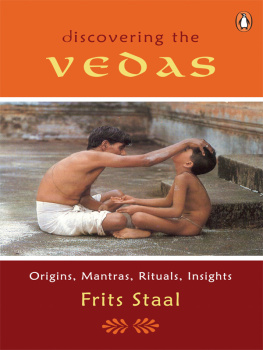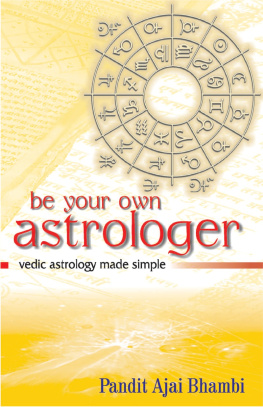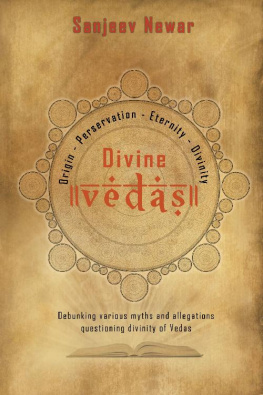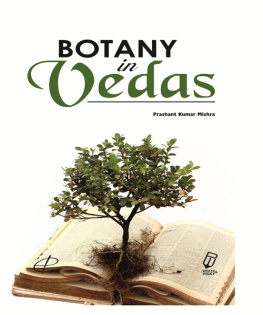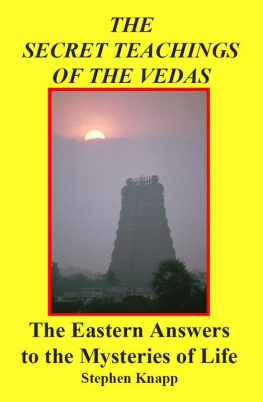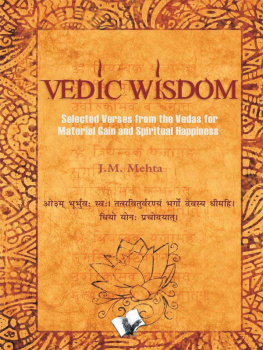FRITS STAAL
Discovering the Vedas
Origins, Mantras, Rituals, Insights

PENGUIN BOOKS
PENGUIN BOOKS
Published by the Penguin Group
Penguin Books India Pvt. Ltd, 11 Community Centre, Panchsheel Park, New Delhi 110 017, India
Penguin Group (USA) Inc., 375 Hudson Street, New York, New York 10014, USA
Penguin Group (Canada), 90 Eglinton Avenue East, Suite 700, Toronto, Ontario M4P 2Y3, Canada (a division of Pearson Penguin Canada Inc.)
Penguin Books Ltd, 80 Strand, London WC2R 0RL, England
Penguin Ireland, 25 St Stephens Green, Dublin 2, Ireland (a division of Penguin Books Ltd)
Penguin Group (Australia), 707 Collins Street, Melbourne, Victoria 3008, Australia (a division of Pearson Australia Group Pty Ltd)
Penguin Group (NZ), 67 Apollo Drive, Rosedale, Auckland 0632, New Zealand (a division of Pearson New Zealand Ltd)
Penguin Books (South Africa) (Pty) Ltd, Block D, Rosebank Office Park, 181 Jan Smuts Avenue, Parktown North, Johannesburg 2193, South Africa
Penguin Books Ltd, Registered Offices: 80 Strand, London WC2R 0RL, England
First published by Penguin Books India 2008
Copyright Frits Staal 2008
, Sanchi Stupa I: East Gate, south pillar, front phase, lower panel, courtesy Archeological Survey of India.
, Procession cart with solid wheels from a temple at Kumbakonam, courtesy National Museum, New Delhi.
Cover photograph courtesy of Adelaide de Menil
Cover design by Mugdha Sadhwani
All rights reserved
ISBN: 978-01-4309-986-4
This digital edition published in 2013.
e-ISBN: 978-81-8475-883-2
This book is sold subject to the condition that it shall not, by way of trade or otherwise, be lent, resold, hired out, or otherwise circulated without the publishers prior written consent in any form of binding or cover other than that in which it is published and without a similar condition including this condition being imposed on the subsequent purchaser and without limiting the rights under copyright reserved above, no part of this publication may be reproduced, stored in or introduced into a retrieval system, or transmitted in any form or by any means (electronic, mechanical, photocopying, recording or otherwise), without the prior written permission of both the copyright owner and the abovementioned publisher of this book.
For
Saraswathy,
Parvati Jeannette
and
Frederik Nanoo Staal
List of Illustrations
List of Tables
Preface
He who studies understands, not the one who sleeps.
Rigveda 5.44.13
The beings of the mind are not of clay.
Byron, Childe Harold
The Vedas are often regarded as abstract and mysterious sacred books. If there is one thing the Vedas are not, it is books: they are oral compositions in a language that was used for ordinary communication; and were handed down by word of mouth like that language itself. Though the Rigveda is said in English to consist of ten books, it is a misleading mistranslation of Sanskrit maala which means cycle. The expression sacred book is also an erroneous appellation. It is applicable to the Bible or Qurn and was insisted upon by missionaries and colonial administrators who could not imagine anything else. It is less easy to explain why this misleading construction has been thoughtlessly embraced by moderns. It is true that the Vedic poets were regarded as inspired and their speech was considered a powerful agent. The Rigveda says: Soma unpressed has never elated Indra, nor its pressed juices unaccompanied by sublime language (brhman) (RV 7.26.1). It nowhere says that the Veda is revealed or ruti, literally what is heard. It is heard only in the sense that it is transmitted from father to son or from teacher to pupil. The Vedas are an Oral Tradition and that applies especially to two of the four: the Veda of Verse (Rig-veda) and the Veda of Chants (Smaveda). Another anachronistic idea is that the Vedas are apaurueya, of non-human origin. They never regard themselves as such. The idea comes from the Prva Mms, a philosophical system that arose several centuries after the end of the Vedas. The Rigveda was composed by poets, human individuals whose names were household words even before there were households: Vivmitra, Friend of All, Bharadvja, Bearing Strength, Drghatamas, Seeing Far Into Darkness. These poets were not addressed by gods. They used the brhman of Vedic invocations to address gods. I have translated brhman as language and not speech, a common rendering, for reasons that will become increasingly clear in the course of this book.
My book will demonstrate that the Vedas are not one or all of a piece. It is easier to say what they are not than what they are. The Vedas had no founder or supreme authority, no popes or pontiffs, and neither were they associated with temples or icons. They refer to a variety of priests with distinct ritual tasks (sixteen in the classical rauta ritual), but no hymns or prayers, English words often met with in translations. There are gods, on earth and in heaven, but they do not dispense grace (with the possible exception of Varua, who came from Bactria). They do not expect loving devotion or bhakti. The Vedas are not a religion in any of the many senses of that widespread term. They have always been regarded as storehouses of knowledge, that is: veda. But they are more than that. They embody a civilization.
The idea of writing a book about the Vedas that addresses both the scholar and the interested lay reader came from Romila Thapar. It was also inspired by Wendy Donigers Rigveda selections published in Penguin Classics, a book that was written for people, not for scholars. That selection of one hundred and eight hymns, a tenth of the Rigveda which is the first and earliest of the four Vedas, contains beautiful translations and a mass of scholarship.
The Vedas are often puzzling; sometimes abstract or mysterious; they may also be muddled; but those are the exceptions, not the rule. They overflow with information, much of it concrete. Part I of my book extracts such information from the Oral Tradition but also from archaeology. It deals with Vedic people and their language, what they thought and did, and where they went and when. Part II, almost twice as long as any of the others, provides essential information about the canonized four Vedas as we know them. It includes selections and translations. Part III seeks to discover and understand not only the facts and where they come from, but what they mean. It is analytic and attempts to shed light especially on mantras and ritual, about which many absurd statements circulate (igayanti as the Rigveda puts it: like words moving around in a sentence). Mantras and rituals are the main channels through which Vedic contributions entered what came to be known as Hinduism.
Part III does not arrive at definite conclusions because I do not believe that we know and understand enough. Part IV tries to answer a rarely asked question: what can we learn from the Vedas? I do not advocate a Vedic lifestyle, but believe that there are things the composers of the Vedas knew and we do not. They include the original forms of the Vedic sciences and the meaning of brhman. Part V, the concluding part, puts the Vedas in perspective in a wide-ranging comparison with Indic philosophies and religions, primarily Buddhism.

